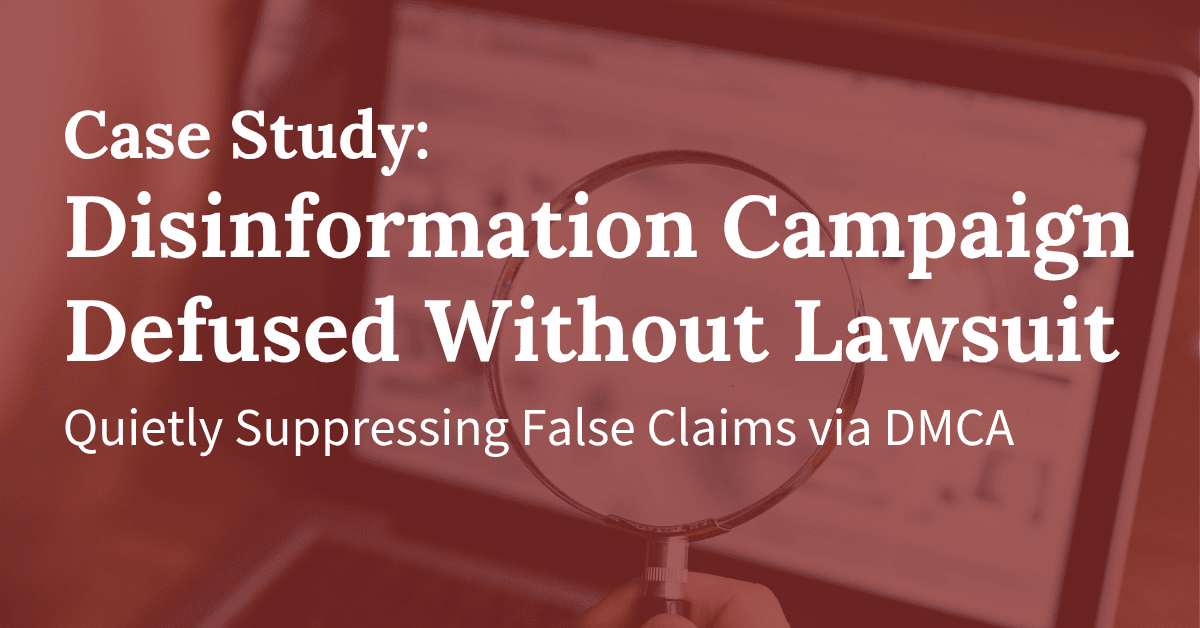
A mid-sized firm discovered an anonymous website publishing fabricated stories about their organization. The content implied fraud, featured invented quotes from leadership, and included plagiarized screenshots designed to look authentic. Worse, the posts were indexing on Google's first page for the company's name and key executive searches.
The leadership team faced a difficult choice: pursue legal action that would amplify visibility and potentially trigger a broader disinformation campaign, or watch their reputation deteriorate in real time. Traditional cease-and-desist letters would alert the anonymous authors to mount a defense or escalate their attacks. Public statements risked drawing media attention to claims that had previously been confined to obscure corners of the internet.
Pholus was brought in to neutralize the threat without escalating visibility, triggering legal discovery, or giving the authors additional ammunition. The situation required precision containment using copyright enforcement tools rather than defamation litigation, combined with strategic silence to avoid feeding the narrative.
This case study is relevant if you're facing:
Anonymous online attacks targeting your organization's reputation. Someone has created websites, social media accounts, or blog posts publishing false information about your company, leadership team, or operations. The content is starting to appear in search results, and you're uncertain whether legal action will make the situation worse by drawing additional attention to the claims.
Defamatory content that doesn't meet the threshold for traditional legal remedies. The posts contain fabricated information and damage your credibility, but your legal counsel has explained that defamation cases are difficult to win, expensive to pursue, and may not be actionable in the jurisdiction where the content originated. You need an alternative approach that removes the content without years of litigation.
Search engine visibility problems caused by malicious actors. When potential clients, partners, or investors search for your organization, they're finding negative content planted by hostile parties. The material includes stolen branding, plagiarized text, and manufactured evidence designed to look credible. You need the content de-indexed before it damages business relationships or investor confidence.
Hostile campaigns that escalate when confronted directly. Previous attempts to address the situation through direct communication or legal threats have backfired, causing the authors to produce more content or expand their attacks. You recognize that visible escalation feeds the problem rather than solving it, and you need a strategy that operates below the threshold of public awareness.
Internal stakeholder pressure to "do something" about online attacks. Your board, investors, or leadership team are demanding action, but you're concerned that reactive measures like press releases, public rebuttals, or aggressive legal filings will amplify the very narrative you're trying to suppress. You need a measured approach that demonstrates control without creating additional exposure.
We conducted a full digital footprint analysis to identify copyright violations rather than pursuing defamation claims. The anonymous blog had lifted brand imagery, company statements, and employee bios verbatim from the client's official website. This created a tactical opening: instead of arguing about truth or falsity in court, we could pursue removal based on clear intellectual property violations. We mapped every domain involved, identified hosting providers, and documented specific instances where copyrighted material appeared without authorization.
We coordinated with in-house legal counsel to draft targeted DMCA notices that removed content without triggering public attention. These notices were narrowly tailored to cite specific copyright violations and avoid aggressive language that might provoke retaliation or prolonged review processes. We directed the notices to Google Search for de-indexing, web hosts to disable infringing pages, and domain registrars where appropriate to flag bad-faith identity use. The approach was surgical, not theatrical.
We implemented narrative containment protocols to prevent reactive communications that would backfire. While the legal takedown proceeded, we advised the client against press releases, public statements, or confrontational social media responses that could amplify the very content we were trying to suppress. Instead, we issued internal talking points for leadership and communications teams in case of media inquiry, monitored traffic and keyword rankings to ensure suppression was holding, and recommended targeted SEO adjustments to push down residual low-value content.
We established three-month follow-on monitoring to ensure the threat didn't resurface through mirror domains or content farms. The anonymous author, seeing no rise in attention or engagement after content disappeared from search results, slowed publication naturally. We tracked for syndicated versions, verified that DMCA notices remained enforced, and worked with the client's search hygiene to normalize their visibility. Stakeholder confidence remained intact throughout, and no formal litigation was required.
The full case study details the copyright enforcement framework we used to remove malicious content without triggering public escalation, the coordination approach between legal and communications teams that preserved stakeholder confidence, and the monitoring protocols that prevented the threat from resurfacing through alternate channels.
If your organization is dealing with anonymous online attacks, fabricated content appearing in search results, or hostile campaigns that escalate when confronted directly, Pholus provides discreet containment strategies that eliminate visibility without inflaming the situation. We specialize in quiet resolution through copyright suppression, coordinated legal-communications responses, and stakeholder containment that protects credibility without creating additional exposure.
This expertise also applies when you're facing reputation risks from former employees, competitors using gray-market tactics, or coordinated disinformation that traditional legal remedies can't address efficiently. When silence is safer than the spotlight, we help you win in the background.